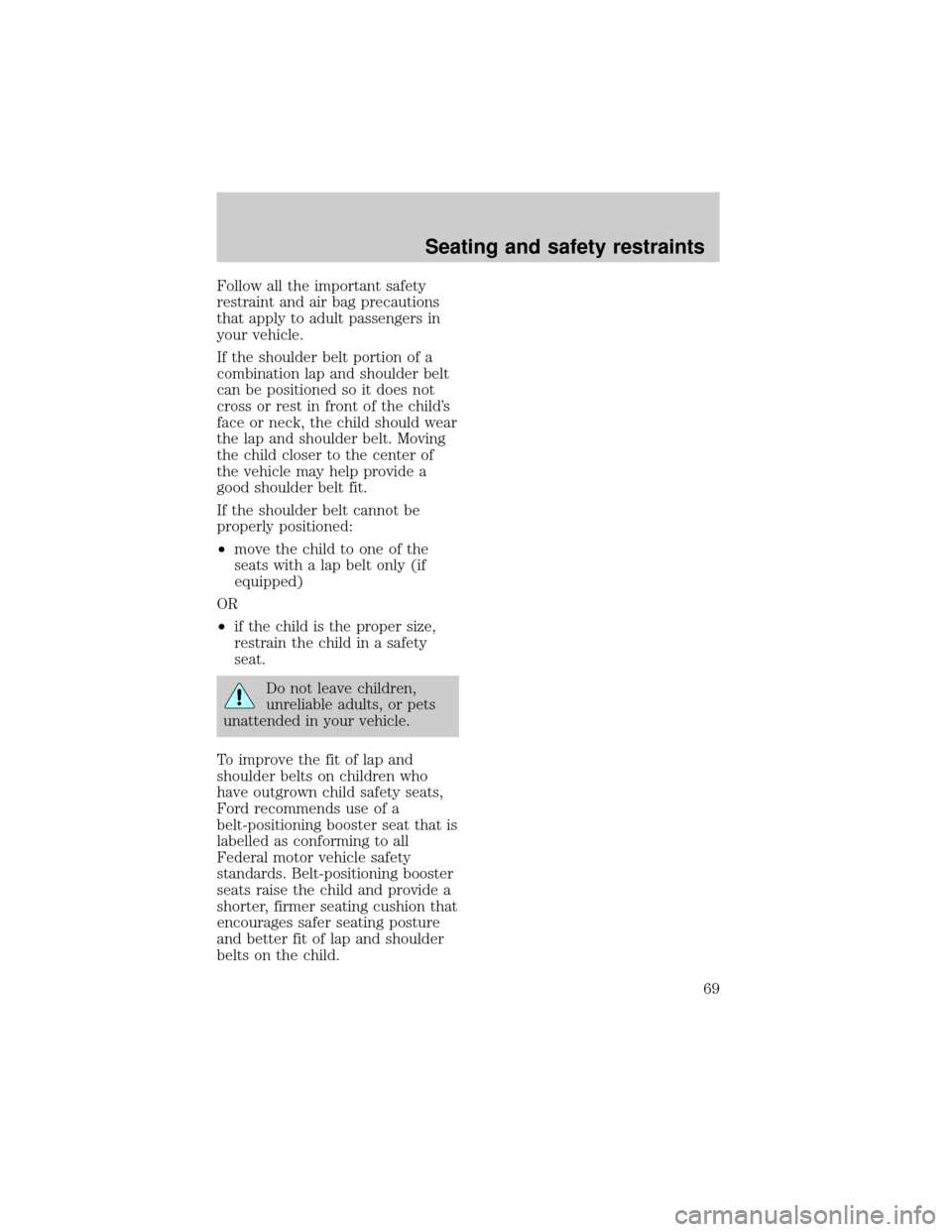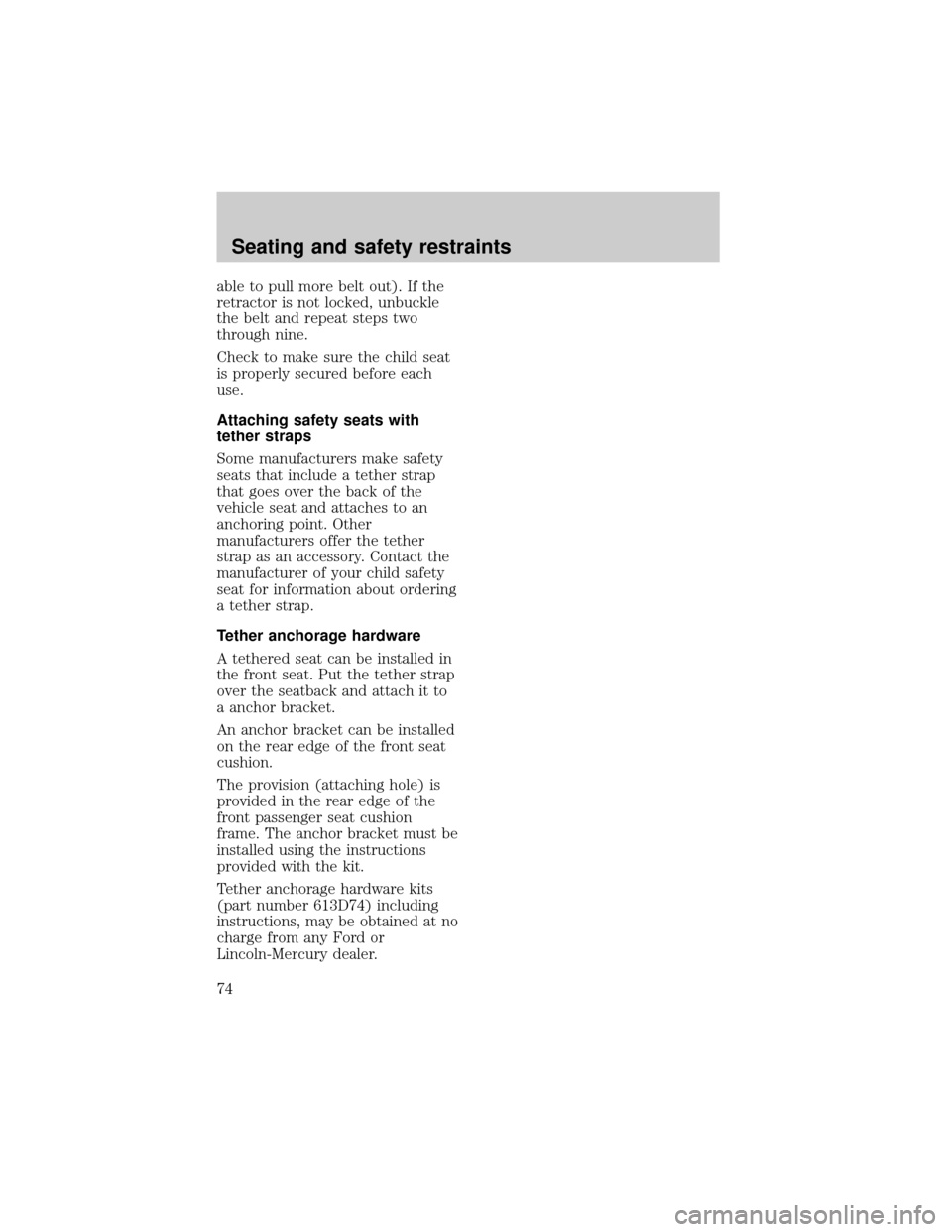Page 69 of 219

Follow all the important safety
restraint and air bag precautions
that apply to adult passengers in
your vehicle.
If the shoulder belt portion of a
combination lap and shoulder belt
can be positioned so it does not
cross or rest in front of the child's
face or neck, the child should wear
the lap and shoulder belt. Moving
the child closer to the center of
the vehicle may help provide a
good shoulder belt fit.
If the shoulder belt cannot be
properly positioned:
²move the child to one of the
seats with a lap belt only (if
equipped)
OR
²if the child is the proper size,
restrain the child in a safety
seat.
Do not leave children,
unreliable adults, or pets
unattended in your vehicle.
To improve the fit of lap and
shoulder belts on children who
have outgrown child safety seats,
Ford recommends use of a
belt-positioning booster seat that is
labelled as conforming to all
Federal motor vehicle safety
standards. Belt-positioning booster
seats raise the child and provide a
shorter, firmer seating cushion that
encourages safer seating posture
and better fit of lap and shoulder
belts on the child.
Seating and safety restraints
69
Page 70 of 219

A belt-positioning booster should
be used if the shoulder belt rests
in front of the child's face or neck,
or if the lap belt does not fit
snugly on both thighs, or if the
thighs are too short to let the child
sit all the way back on the seat
cushion when the lower legs hang
over the edge of the seat cushion.
You may wish to discuss the
special needs of your child with
your pediatrician.
SAFETY SEATS FOR CHILDREN
Child and infant or child safety
seats
Use a safety seat that is
recommended for the size and
weight of the child. Carefully
follow all of the manufacturer's
instructions with the safety seat
you put in your vehicle. If you do
not install and use the safety seat
properly, the child may be injured
in a sudden stop or collision.
When installing a child safety seat:
²Use the correct safety belt
buckle for that seating position.
²Make sure the tongue is
securely fastened in the buckle.
²Keep the buckle release button
pointing up and away from the
safety seat, with the tongue
between the child seat and the
release button, to prevent
accidental unbuckling.
Seating and safety restraints
70
Page 71 of 219
²Place seat back in upright
position.
²Put the safety belt in the
automatic locking mode. Refer
toAutomatic locking mode.
Ford recommends the use of a
child safety seat having a top
tether strap. Install the child safety
seat in a seating position which is
capable of providing a tether
anchorage. For more information
on top tether straps, refer to
Attaching safety seats with tether
straps.
Carefully follow all of the
manufacturer's instructions
included with the safety seat you
put in your vehicle. If you do not
install and use the safety seat
properly, the child may be
injured in a sudden stop or
collision.
Installing child safety seats in
combination lap and shoulder
belt seating positions
1. Position the child safety seat in
a seat with a combination lap and
shoulder belt.
Seating and safety restraints
71
Page 72 of 219
Air bag can kill or injure a
child in a child seat. If you
must use a forward-facing child
seat in the front seat, move seat
all the way back.
2. Pull down on the shoulder belt
and then grasp the shoulder belt
and lap belt together.
3. While holding the shoulder and
lap belt portions together, route
the tongue through the child seat
according to the child seat
manufacturer's instructions. Be
sure the belt webbing is not
twisted.
4. Insert the belt tongue into the
proper buckle for that seating
position until you hear and feel the
latch engage. Make sure the
tongue is latched securely by
pulling on it.
PRESS
Seating and safety restraints
72
Page 73 of 219
5. To put the retractor in the
automatic locking mode, grasp the
shoulder portion of the belt and
pull downward until all of the belt
is extracted and a click is heard.
6. Allow the belt to retract. The
belt will click as it retracts to
indicate it is in the automatic
locking mode.
7. Pull the lap belt portion across
the child seat toward the buckle
and pull up on the shoulder belt
while pushing down with knee on
the child seat.
8. Allow the safety belt to retract
to remove any slack in the belt.
9. Before placing the child in the
seat, forcibly tilt the seat forward
and back to make sure the seat is
securely held in place.
10. Try to pull the belt out of the
retractor to make sure the
retractor is in the automatic
locking mode (you should not be
Seating and safety restraints
73
Page 74 of 219

able to pull more belt out). If the
retractor is not locked, unbuckle
the belt and repeat steps two
through nine.
Check to make sure the child seat
is properly secured before each
use.
Attaching safety seats with
tether straps
Some manufacturers make safety
seats that include a tether strap
that goes over the back of the
vehicle seat and attaches to an
anchoring point. Other
manufacturers offer the tether
strap as an accessory. Contact the
manufacturer of your child safety
seat for information about ordering
a tether strap.
Tether anchorage hardware
A tethered seat can be installed in
the front seat. Put the tether strap
over the seatback and attach it to
a anchor bracket.
An anchor bracket can be installed
on the rear edge of the front seat
cushion.
The provision (attaching hole) is
provided in the rear edge of the
front passenger seat cushion
frame. The anchor bracket must be
installed using the instructions
provided with the kit.
Tether anchorage hardware kits
(part number 613D74) including
instructions, may be obtained at no
charge from any Ford or
Lincoln-Mercury dealer.
Seating and safety restraints
74
Page 75 of 219
If you have a SuperCab, attach the
bracket to the inside of the back
panel of your vehicle. Carefully
follow the instructions provided
with the kit.
If you have a SuperCab Ford
recommends you attach tether
safety seats in the rear seating
position (if possible) with the
tether strap attached to the tether
anchorage bracket as shown in the
instructions provided with the
tether anchor kit.
Tighten the anchor
according to specifications.
Otherwise, the safety seat may
not be properly secured and the
child may be injured in a sudden
stop or collision.
Seating and safety restraints
75
Page 216 of 219

Air bag supplemental restraint
system ..........................................60
and child safety seats ..............61
description ................................60
disposal ......................................64
indicator light ...........................63
passenger air bag ...........62,65,66
Air conditioning
manual heating and air
conditioning system .......22,23,26
Air suspension
description ................................87
warning light .............................11
Ambulance packages ....................3
Anti-lock brake system (ABS)
description ................................84
Anti-theft system ........................40
Battery .......................................175
voltage gauge ............................16
Brake fluid
checking and adding ..............162
Brakes ..........................................83
anti-lock .....................................83
anti-lock brake system (ABS)
warning light .............................84
fluid, checking and adding ....162
Brake-shift interlock ...................88
Break-in period .............................2
Bulbs, replacing ........................192
headlamps ...............................193
specifications ..........................197
Changing a tire .........................141
Child safety seats ........................70
Chime
headlamps on ............................12
Cleaning your vehicle ...............198
engine compartment ..............200
fabric ........................................201
instrument panel ....................201
plastic parts ............................201
safety belts ..............................202
tail lamps .................................201washing ....................................198
waxing .....................................199
wheels ......................................199
Clutch
fluid ..........................................163
Controls .......................................19
Daytime running light system ...17
Driving under special
conditions ..................................105
high water ...............................105
slippery roads ..................106,107
Emission control system ..........189
Engine ........................................210
check engine temperature
warning, message
center ...............................155,156
service points ..........................155
Engine block heater ...................80
Engine coolant
checking and adding .......164,165
disposal ....................................166
refill capacities ........................167
Engine oil ...........................156,160
changing oil and oil filter .......161
checking and
adding ........................156,158,160
Exhaust fumes ............................81
Fail safe cooling ........................168
Foglamps ............................196,197
Four-Wheel Drive vehicles .........98
control trac ........................19,102
indicator light ...........................99
lever operated electric shift ....99
Fuel
calculating fuel economy .......188
improving fuel economy ........130
octane rating ...........................187
quality ......................................187
safety information relating to
automotive fuels .....................184
Fuel gauge ...................................13
Fuel pump shut-off switch .......131
Index
216